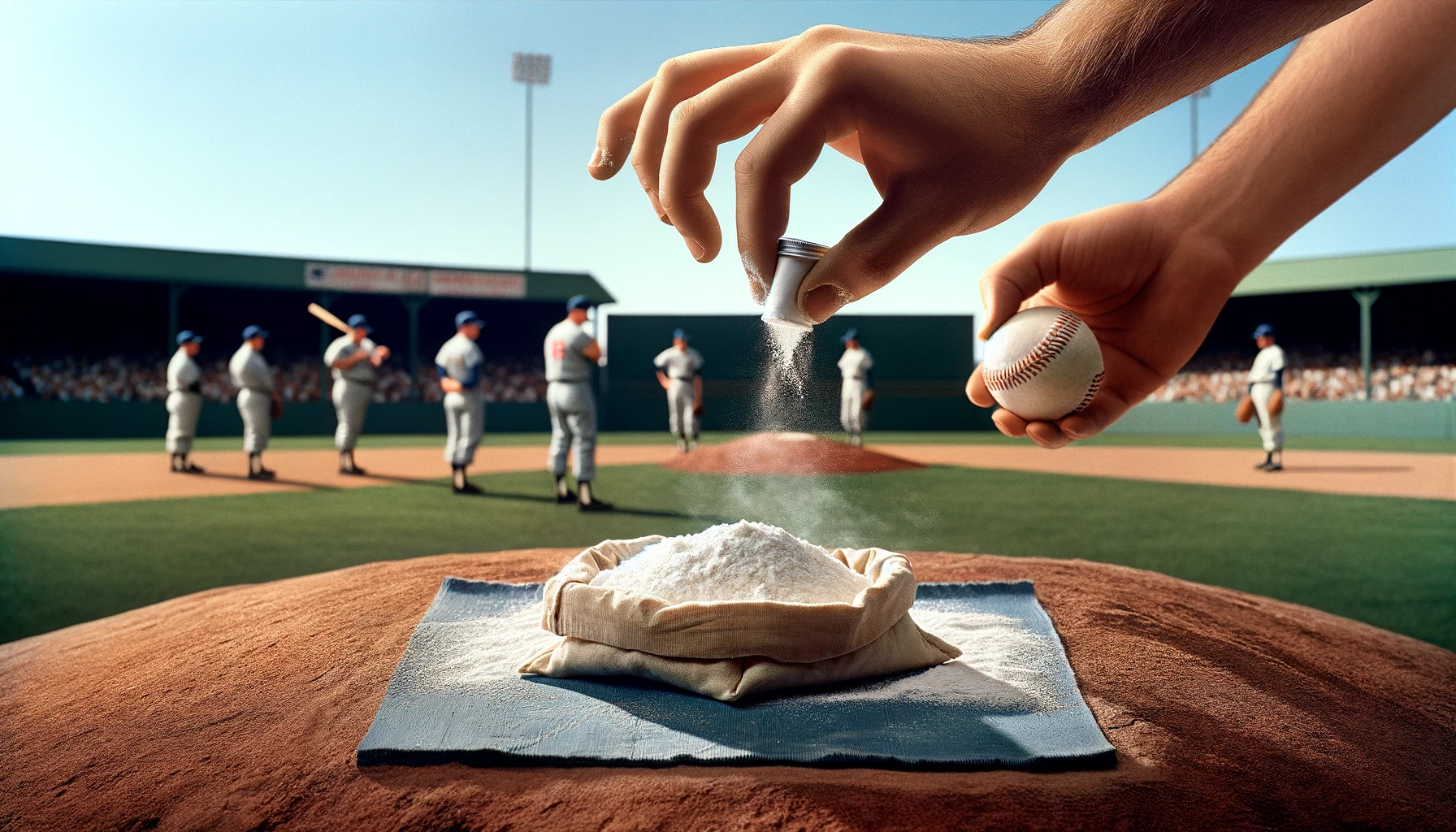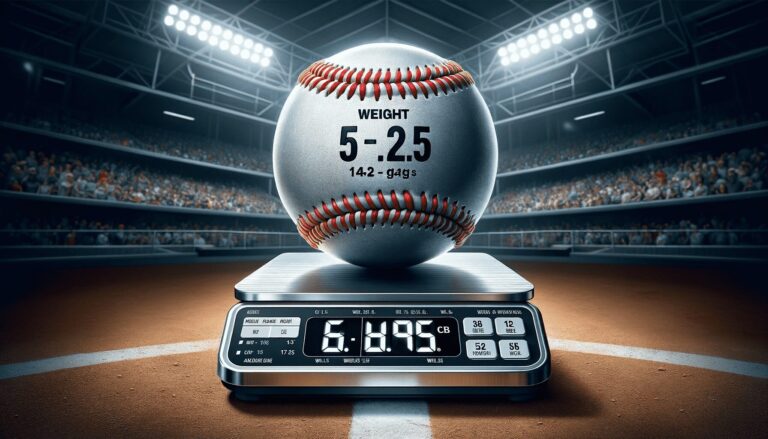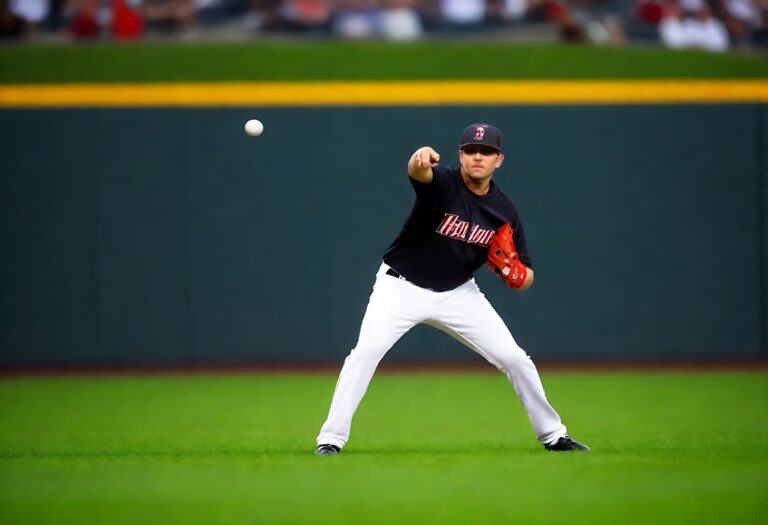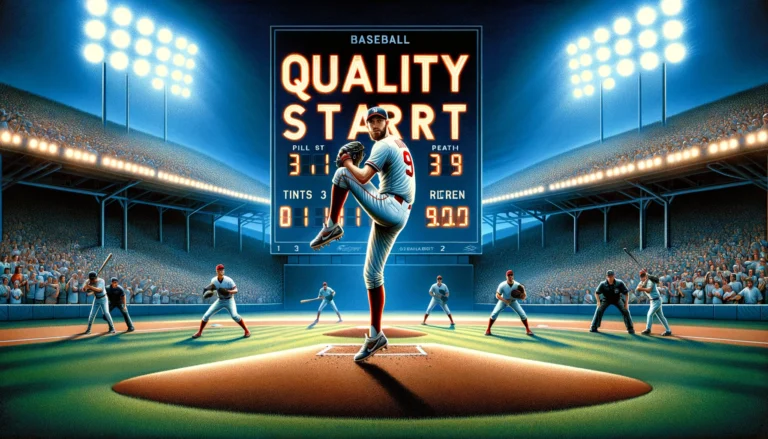What is Rosin in Baseball?
Rosin is a solid form of resin that comes from pine trees and is used to improve grip. In baseball, pitchers use it to get a better hold on the ball, especially in hot or humid conditions where hands might get slippery.
This simple tool helps them control their pitches more effectively.
In this article, we’ll explore how rosin is used in baseball, why it’s important, and the rules surrounding its use.
Key Takeaways
- Rosin is a legal grip aid in baseball used to replace prohibited practices like finger licking, especially important during health crises requiring social distancing.
- The crackdown on foreign substances has led to high-profile accusations, such as those against Gerrit Cole, and debates over the relationship between these substances and pitchers’ performance.
- Pitchers, including Tyler Glasnow, have suggested that the ban on substances like sunscreen and rosin mixtures may contribute to an increase in injuries, a claim supported by anecdotal evidence but still under scrutiny.
- MLB’s response to the rise in pitcher injuries has been criticized by players like Gerrit Cole, who points to multiple factors contributing to these injuries, not just the tack ban.
- The future of pitching in MLB is likely to see further rule changes and innovations as the league seeks to balance player safety with the quality of the game and the performance of its athletes.
Understanding Rosin’s Role in Baseball

The Basics of Rosin and Its Use on the Mound
Rosin, a solid form of resin obtained from pines and other conifers, has been a staple on the pitcher’s mound for decades.
Its primary function is to enhance a pitcher’s grip on the baseball, especially under conditions where sweat, humidity, or other factors might make the ball slippery.
The use of roin is particularly crucial because it allows pitchers to maintain control over their pitches without resorting to illegal substances.
The application of rosin is straightforward and is part of the pitcher’s routine:
- A pitcher takes a small amount of rosin from the rosin bag.
- They rub it between their hands to create a tacky substance.
- The tacky substance is then applied to the fingers or the ball to improve grip.
While rosin is legal and widely accepted in baseball, its use has come under greater scrutiny as part of the broader conversation about ‘sticky stuff’ and the advantages it may provide.
Despite this, rosin remains a legal and essential tool for pitchers to perform at their best while adhering to the rules of the game.
Adapting to New Norms: Rosin as a Legal Grip Aid
In the ever-evolving game of baseball, rosin has emerged as a legal aid for pitchers seeking to enhance their grip on the ball.
Unlike pine tar, which is prohibited for pitchers, rosin is sanctioned under the rules of the game.
This distinction is crucial, as it allows pitchers to maintain a level of control without resorting to illegal substances.
The use of rosin is straightforward and involves a few simple steps:
- The pitcher takes a small amount of rosin from the rosin bag.
- They then rub it onto their hands or the ball to improve grip.
- Excess rosin can be dusted off to ensure the ball is not overly sticky.
This process helps pitchers adapt to the ban on other grip enhancers, such as the combination of sunscreen and rosin, which has been linked to injuries like those suffered by Tyler Glasnow.
As the game’s regulations continue to change, players and officials alike are learning to navigate these new norms, balancing the need for control with the integrity of the sport.
The Impact of Rosin on Pitchers’ Performance
Rosin’s introduction to baseball has been a game-changer for pitchers, particularly in the wake of health and safety measures that have altered traditional practices.
The use of rosin bags has become essential for maintaining a grip on the ball, especially since the ban on finger licking is due to hygiene concerns.
- Rosin provides a legal way for pitchers to enhance their grip without resorting to illegal substances.
- The tackiness it offers can lead to increased spin rates, which in turn affects the movement and effectiveness of pitches.
- Some pitchers have reported changes in their pitching mechanics as a result of relying on rosin, which could potentially lead to increased soreness or injury.
While rosin role in the game is largely positive, it’s important to consider its long-term effects on players’ health.
As the league continues to adapt, the balance between performance enhancement and injury prevention remains a critical conversation.
Read Also: What is Arbitration in Baseball
The Evolution of Pitching Etiquette Amidst Health Concerns
From Handshakes to Hat Tips: The Shift in Post-Game Traditions
The conclusion of a baseball game has traditionally been marked by a display of sportsmanship, with players from opposing teams shaking hands as a sign of mutual respect.
However, recent health concerns have prompted a shift in this ritual. Now, players acknowledge each other by simply tipping their hats from a safe distance.
- The change reflects a broader trend of adapting to new safety protocols on the field.
- It maintains the spirit of camaraderie while respecting health guidelines.
This modification in post-game etiquette is just one of the many ways baseball has adapted to ensure the safety of its players.
The ban on finger licking, once a common practice for pitchers seeking better grip, has also led to an increased reliance on rosin bags.
These bags, filled with a powdery substance, have become an essential tool for pitchers to maintain control of the ball without compromising health standards.
Social Distancing and Safety Measures on the Field
The pandemic has necessitated a host of new safety protocols in baseball, fundamentally altering the player experience both on and off the field.
Social distancing measures have been particularly impactful, with players often seen sitting in chairs spaced apart, extending beyond the confines of the dugout to maintain distance.
Masks have become a ubiquitous accessory, required to be worn at all times except during active play.
This adherence to mask-wearing, while initially challenging, has become second nature for many athletes as they recognize the gravity of the situation and the potential consequences of non-compliance.
The collective goal is clear: to prevent any disruption to the season akin to the previous year’s cancellations.
Here are some of the key changes players have adapted to:
- Daily symptom checks and temperature recordings.
- Mandatory mask usage during practice sessions.
- Modified post-game traditions, replacing handshakes with hat tips and distanced acknowledgments.
These adjustments, while seen by some as excessive, are largely accepted as necessary steps to ensure the health and continuity of the sport.
The ban on finger licking, a pitcher’s traditional method for improving grip, has given way to an increased reliance on rosin bags, highlighting the sport’s ability to adapt while prioritizing safety.
The Ban on Finger Licking and the Rise of Rosin
In the wake of health concerns and the ban on finger licking, pitchers have increasingly turned to rosin to maintain a firm grip on the ball.
The rule change has necessitated a shift in how pitchers interact with the ball, leading to a reliance on legal grip aids like rosin bags.
- Rosin, a sticky substance derived from pine trees, is allowed by the rules as long as it is not applied directly to the ball.
- Pitchers are often seen patting their hands on the rosin bag before taking the mound, a ritual that has become more pronounced since the ban on saliva-based grip methods.
The use of rosin has become a focal point in discussions about pitcher performance and injury prevention.
As pitchers adapt to the new norms, the impact of these changes on their health and effectiveness continues to be a topic of debate within the baseball community.
Read Also: What is a Hold in Baseball
The Controversy Surrounding ‘Sticky Stuff’ in Baseball

The Crackdown on Foreign Substances and Its Aftermath
In June 2021, Major League Baseball (MLB) implemented a strict policy against the use of foreign substances by pitchers.
This decision came after growing concerns that such substances were being used to enhance grip and, consequently, spin rates on pitches.
The immediate effect was a noticeable decline in spin rates across the league, which some argue has leveled the playing field between pitchers and hitters.
The crackdown led to a series of inspections and suspensions, as players found in violation faced significant penalties.
The enforcement of this rule change:
- Prompted pitchers to adapt to pitching without the aid of foreign substances.
- Sparked debates over the necessity and fairness of such stringent regulations.
- Raised questions about the potential impact on pitchers’ health and performance.
Despite the controversy, the MLB’s firm stance on foreign substances has set a new standard for the integrity of the game.
However, the debate continues as to whether this has inadvertently contributed to the rise in pitching injuries, a topic that has garnered significant attention and concern.
High-Profile Cases: The Accusations Against Gerrit Cole
The spotlight on the use of ‘sticky stuff’ in baseball intensified with the accusations against New York Yankees’ star pitcher Gerrit Cole.
Cole’s dramatic increase in spin rate after his trade from Pittsburgh to Houston raised suspicions among peers and fans alike.
His former college teammate, Trevor Bauer, publicly questioned the sudden improvement, hinting at the use of prohibited substances to enhance performance.
Cole found himself embroiled in controversy when he was mentioned in a lawsuit involving Bubba Harkins, a former Angels clubhouse attendant.
Harkins admitted to concocting a special pine-tar mixture for pitchers, implicating several in the scandal.
The accusations gained further traction as Cole’s performances fluctuated amidst MLB’s crackdown on illegal grip aids.
His struggles on the mound, followed by a commanding 129-pitch complete game shutout, left many to wonder about the correlation between his performance and the use of such substances.
The debate over the legitimacy of Cole’s achievements continues to be a contentious topic, with the following points often discussed:
- Cole’s transition from a good young pitcher to a dominant force in the league.
- The role of analytics and pitching techniques versus the alleged use of sticky substances.
- The impact of MLB’s enforcement policies on pitchers’ performances and reputations.
The Debate Over Injury Risks and Performance Enhancers
The intersection of injury risks and the use of performance enhancers in baseball has sparked a heated debate.
On one side, there’s a growing concern that the ban on sticky substances, or ‘tack’, is leading to an increase in pitcher injuries.
This hypothesis suggests that without the aid of tack, pitchers are forced to grip the ball differently, potentially straining their arms more than before.
- The ban on sticky substances has changed how pitchers handle the ball.
- There is a hypothesis that this change is contributing to a rise in injuries.
- High-profile players have voiced concerns about the impact of rule changes.
Furthermore, players like Tyler Glasnow have publicly attributed their injuries to the lack of grip-enhancing substances.
Gerrit Cole has also highlighted multiple factors contributing to arm injuries, including the crackdown on sticky stuff and the quest for maximum velocity and spin.
The debate continues as the league and players seek a balance between maintaining player health and ensuring the integrity of the game.
Read Also: What is a Cycle in Baseball
Injuries and the Tack Ban: Correlation or Causation?
Tyler Glasnow’s Injury: A Case Study
Tyler Glasnow’s injury became a focal point in the debate over the MLB’s ban on ‘sticky stuff.’
Glasnow attributed his UCL injury to the sudden enforcement of the ban, which prohibited the use of substances like sunscreen and rosin combined, a mixture he had relied upon for grip.
The ban led to a change in how pitchers gripped the baseball, potentially increasing the risk of injury.
- Glasnow’s own experience after stopping the use of the mixture was telling; he reported feeling sore and different following a game where he struck out 11 batters but had gone ‘cold turkey’ on the substance.
- The resurfacing of an old video where Glasnow explains the potential link between the tack ban and his injury underscores the concerns shared by many in the league.
The case of Glasnow is not isolated, as other pitchers recovering from elbow surgeries, such as Shohei Ohtani and Jacob deGrom, may also be affected by the new regulations.
The implications of the ban extend beyond individual cases, prompting a league-wide examination of pitcher health and performance.
The Argument Against the Tack Ban and Its Implications
The debate over the tack ban in baseball has intensified, with a faction of the baseball community suggesting that the prohibition of sticky substances is leading to an increase in pitcher injuries.
Critics argue that the ban forces pitchers to alter their grip on the ball, potentially causing more strain on their arms.
This hypothesis is supported by anecdotal evidence, including a resurfaced video of pitcher Tyler Glasnow discussing how the tack ban may have contributed to his injury.
The implications of this argument are significant for the sport. If the tack ban is indeed causing harm, it could lead to:
- A higher rate of pitcher injuries
- A decrease in the quality of play
- Potential disputes between the MLB and the MLBPA
However, the league maintains that there is no empirical evidence linking the pitch clock to pitcher injuries.
This ongoing dispute highlights the need for further research and dialogue to ensure the health and performance of players are not compromised.
The Future of Pitching Health in Major League Baseball
As Major League Baseball grapples with the rise in pitcher injuries, the focus on player health has never been more critical.
The MLB’s response to the Players Association highlights the complexity of factors contributing to this trend.
Gerrit Cole’s recent comments underscore the multifaceted nature of the issue, pointing to the importance of maximum velocity and spin, as well as the crackdown on sticky substances, as potential culprits.
The league must consider various elements that may influence pitcher health:
- The impact of the pitching clock and adequate rest between pitches
- The effects of the tack ban on grip and arm stress
- The need for a consistent standard in equipment, from balls to bats
Finding a balance between competitive play and the well-being of athletes is paramount. The future of baseball hinges on the ability to ensure the safety and longevity of its players, while maintaining the integrity and excitement of the game.
See Also: What is a Bullpen in Baseball
The Future of Pitching: Balancing Safety and Performance

MLB’s Response to the Rise in Pitcher Injuries
In the wake of increasing pitcher injuries, Major League Baseball has faced criticism for its handling of the situation.
Players and the MLB Players Association have voiced concerns over the league’s policies, particularly the introduction of a faster pitching clock, which some believe may not allow pitchers adequate rest between pitches.
This, coupled with the ban on sticky substances, has led to a complex debate about the causes of these injuries.
Key points raised by players include:
- The need for pitchers to achieve maximum velocity and spin to counteract advanced hitters.
- A perceived reduction in the size of the strike zone.
- Variability in the quality of baseballs and improvements in bat technology.
MLB has yet to announce a comprehensive plan to address these issues, but the dialogue between the league and the Players Association continues.
The hope is that a resolution can be reached that prioritizes player health without compromising the quality of the game.
The Search for a Middle Ground: Players’ Perspectives
In the quest for a middle ground, players like Gerrit Cole express frustration with the lack of focus on player health and the combative nature of discussions between the MLB and the Players Association.
Cole emphasizes the need for constructive dialogue rather than finger-pointing, suggesting that the well-being of players seems to be sidelined.
Players are calling for a unified approach to address the issues at hand, likening the current situation to a child caught between divorced parents unable to agree.
The sentiment is that both the league and the association should prioritize finding solutions that safeguard players’ health and the integrity of the game.
The multifaceted nature of the problem is acknowledged, with factors such as the quest for maximum velocity, the evolving strike zone, and the variability of equipment all contributing to the rise in arm injuries.
Players are advocating for a comprehensive review of these elements to ensure that the future of baseball remains bright and that player welfare is not compromised.
Innovations and Rule Changes: The Path Ahead for Baseball
As Major League Baseball grapples with the delicate balance between ensuring player safety and maintaining the competitive integrity of the game, innovations and rule changes are at the forefront of the discussion.
The introduction of a pitch clock has been a significant change, aimed at speeding up the game. However, its impact on pitcher health remains a contentious issue.
MLB has cited a study from Johns Hopkins which reportedly found no link between the pitch clock and arm injuries, a claim met with skepticism from players like Justin Verlander.
The evolution of equipment and training methods also continues to shape the future of pitching.
From the development of more consistent baseballs to the potential use of wearable technology for monitoring player health, the path ahead is paved with both opportunities and challenges.
Players and the league must navigate these changes collaboratively, ensuring that the drive for performance does not compromise the well-being of the athletes.
Ultimately, the ongoing dialogue between MLB, the Players Association, and medical experts will be crucial in determining the most effective strategies for reducing injuries while enhancing the game.
The quest for a middle ground continues, as the baseball community seeks to uphold the traditions of the sport while embracing the possibilities that innovation brings.
Conclusion
In conclusion, the role of rosin in baseball has become a focal point of controversy and adaptation in the sport.
As pitchers navigate the ban on ‘sticky stuff’ and the limitations on traditional methods like licking fingers, rosin bags have emerged as a critical tool for maintaining grip.
The debate over its use, highlighted by the experiences of players like Gerrit Cole and Tyler Glasnow, underscores the delicate balance between ensuring fair play and protecting player health.
The MLB’s enforcement of new regulations has sparked discussions about the unintended consequences, including a potential increase in pitcher injuries.
As the league continues to evolve, it’s clear that the conversation around rosin and pitcher grip is far from over, and its resolution will be instrumental in shaping the future of baseball.
Frequently Asked Questions
What is rosin and why is it used in baseball?
Rosin is a solid form of resin obtained from pines and other conifers. Baseball pitchers use rosin to improve their grip on the ball, especially since rules prohibit licking fingers on the mound.
Is rosin considered a legal substance for pitchers in baseball?
Yes, rosin is legal in baseball. It is provided in a rosin bag behind the pitcher’s mound for use during the game to help pitchers maintain a good grip on the ball.
How has the ban on finger licking affected pitchers’ performance?
The ban on finger licking has led pitchers to rely more on rosin for grip. Some pitchers have experienced changes in their performance and an increase in soreness due to altered grip techniques.
What are the major concerns surrounding the ‘sticky stuff’ controversy in baseball?
The controversy involves the use of illegal grip-enhancing substances, beyond rosin, which may improve pitch control and spin rate. The crackdown on these substances has led to debates over fairness, performance, and pitcher injuries.
How did the sunscreen and rosin combination affect pitchers like Tyler Glasnow?
Tyler Glasnow attributed his UCL injury to the discontinuation of using a mix of sunscreen and rosin, which he claimed affected his ability to grip the ball comfortably and may have contributed to his injury.
What is Major League Baseball’s stance on the increase in pitcher injuries?
MLB has acknowledged the rise in pitcher injuries and is examining multiple factors, including the ban on sticky substances. They are seeking a balance between player safety and maintaining the integrity of the game.







